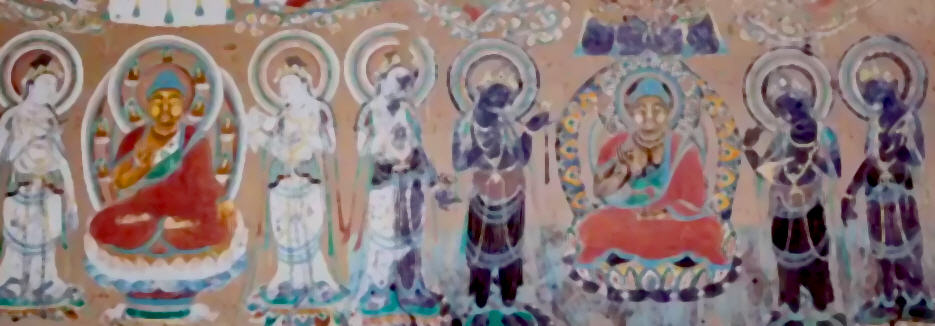Origins of Buddhism
佛教起源
佛教起源於古印度河流域迦毗羅衛國(現今尼泊爾和印度邊界間靠近尼泊爾)。當時的王室太子悉達多·喬答摩於35歲修道成爲释迦牟尼佛後, 在約前6世紀以對弟子開示的 “苦、集、滅、道” 的教導內容,因緣轉趨為宗教化,成為現代世界三大宗教之一。對於世界上,尤其是東亞、中南半島文化具有深刻的影响。此外在中亞、南亞和南洋群島地區的文化曾具有廣泛的影響,现正在向歐洲、非洲、北美洲發展。
佛教經歷史發展,通過南、北兩條傳播途徑,現代存在南傳上座部佛教、北傳大乘佛教兩條支脈,其中大乘佛教又分為顯宗(漢傳佛教的主要內容)和密宗(藏傳佛教的主要內容),故也有上座部、漢傳佛教(大乘)、藏傳佛教(金剛乘)三分法,各脈又有諸多宗派;南傳主要爲以聲聞乘、阿羅漢果爲最高聖位,北傳則追求在未來世成佛,皆稱爲涅槃。
Buddhism is originated in ancient India’s Indus River Basin at Kapilavastu district (now Nepal). Founded by Prince Siddhartha around 6 BCE, he lived a royal life up to the age of 29, then renunciate from his family and became an ascetic. Seeking for the ultimate truth for six years, undergoing many obstacles and hardship, he attained Supreme Enlightenment at the age of 35 and became known as Gautama Buddha. He then taught the Four Noble Truth of Suffering, the Arising of Suffering, the Cessation of Suffering and the Path. His teachings have evolved into one of the three major religions in the modern world . His teachings have a profound influence on the world, especially to the culture of East Asia, the Indochina Peninsula, Central Asia , South Asia and the South Sea Islands, and is now developing in Europe , Africa and North America .
Through the routes of northern and southern transmission, in the historical development of Buddhism, it has evolved into two main schools. The southern transmission has progressed into Theravada school, while the northern movement has developed into Mahayana school. Further, Mahayana school has branched into Chinese Mahayana school specializing in scriptures and doctrines, and Vajrayana school focusing on tantra and mantra practices. This movement of spiritual and religious practice are known as the three main classifications of Buddhism to date, namely Theravada, Mahayana and Vajrayana. While the Theravada school considered Sravakayana or Arhat status as highest arch of achievement, Mahayana school further vowed to pursuit Buddhahood, also known as Nirvana.
The life of Buddha Shakyamuni
簡述釋迦摩尼佛的生平
釋迦牟尼佛,(约公元前六世紀) 本是古印度迦毘羅衛國(今尼泊爾境內)的太子,父為淨飯王,母為摩耶夫人,佛陀為太子時名叫“喬達摩·悉達多” ,意為“一切義成就者”。
佛陀以本誓願,於娑婆世界,五濁惡世示現成佛,開顯佛教,度化眾生.釋迦牟尼的意思是“能仁” 、 “能儒” 、 “能忍” 、 “能寂” 等,因父為釋迦族,成道後被尊稱為釋迦牟尼,義即 “釋迦族的聖人”。
據佛經記載,佛陀在29歲時,有感於人世生、老、病、死等諸多苦惱,捨棄王族生活, 出家修行。35歲在菩提樹下悟道後,佛陀說道:” 奇哉,奇哉! 一切眾生皆有如來智慧德相,乃因妄想執着而不能証得”。遂開啟佛教,弘法49年。年80歲左右在拘尸那迦城示現涅槃。
The founder of Buddhism, Shakyamuni Buddha, (approx. 6th BCE) was originally the prince of the ancient Indian kingdom, Kapilavastu (in the present Nepal). His father was king Śuddhodana, leader of the Shakya clan in what was the growing state of Kosala, and his mother was queen Maya Devi.
As the crown prince, his name was “Gautama Siddhartha", which means "all righteous achievement". According to his vow, he became a Buddha in this Saha world, the world of five turbid and evils, in order to teach Buddhism and deliver all sentient beings. Shakyamuni means great benevolence, capability, endurance and stillness. Due to his lineage from the Shakya Clan, he was honored as Sakyamuni after enlightenment. Shakyamuni is an honorific of the historical Buddha, meaning “Sage of the Shakyans,” the Shakyans being the kingdom world where the Buddha-to-be was born.
According to Buddhist scriptures, when the Buddha was 29 years old, he was overwhelmed by the suffering in the world caused by impermanence of birth, old age, sickness and death. He gave up his royal life and became an ascetic, in search of the ultimate truth in life. At the age of 35, he attained Supreme Enlightenment under the Bodhi tree and became a Buddha. He then proclaimed: “How astonishing! All sentient beings have the potentiality to attain Buddhahood. It is only because of our illusionary cravings that hindered us from revealing our Buddha nature.” He then taught Buddhism for 49 years. At the age of 80, he entered Nirvana at Kusinara.

